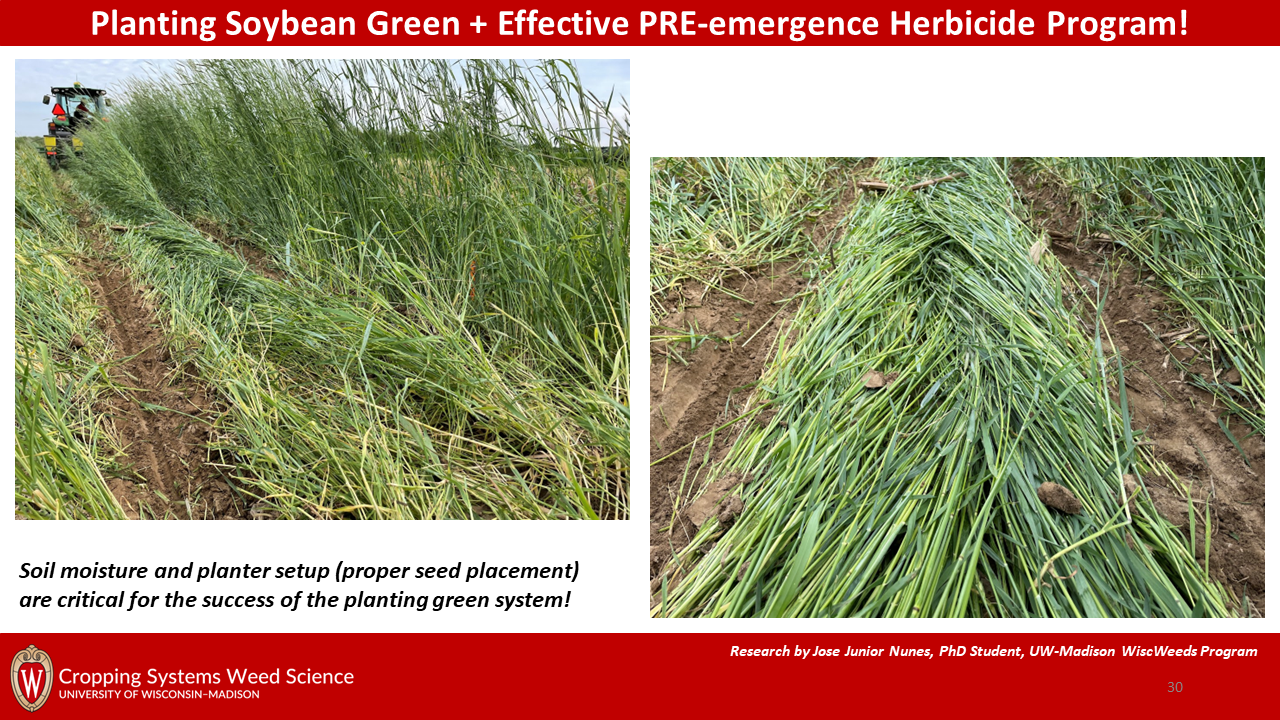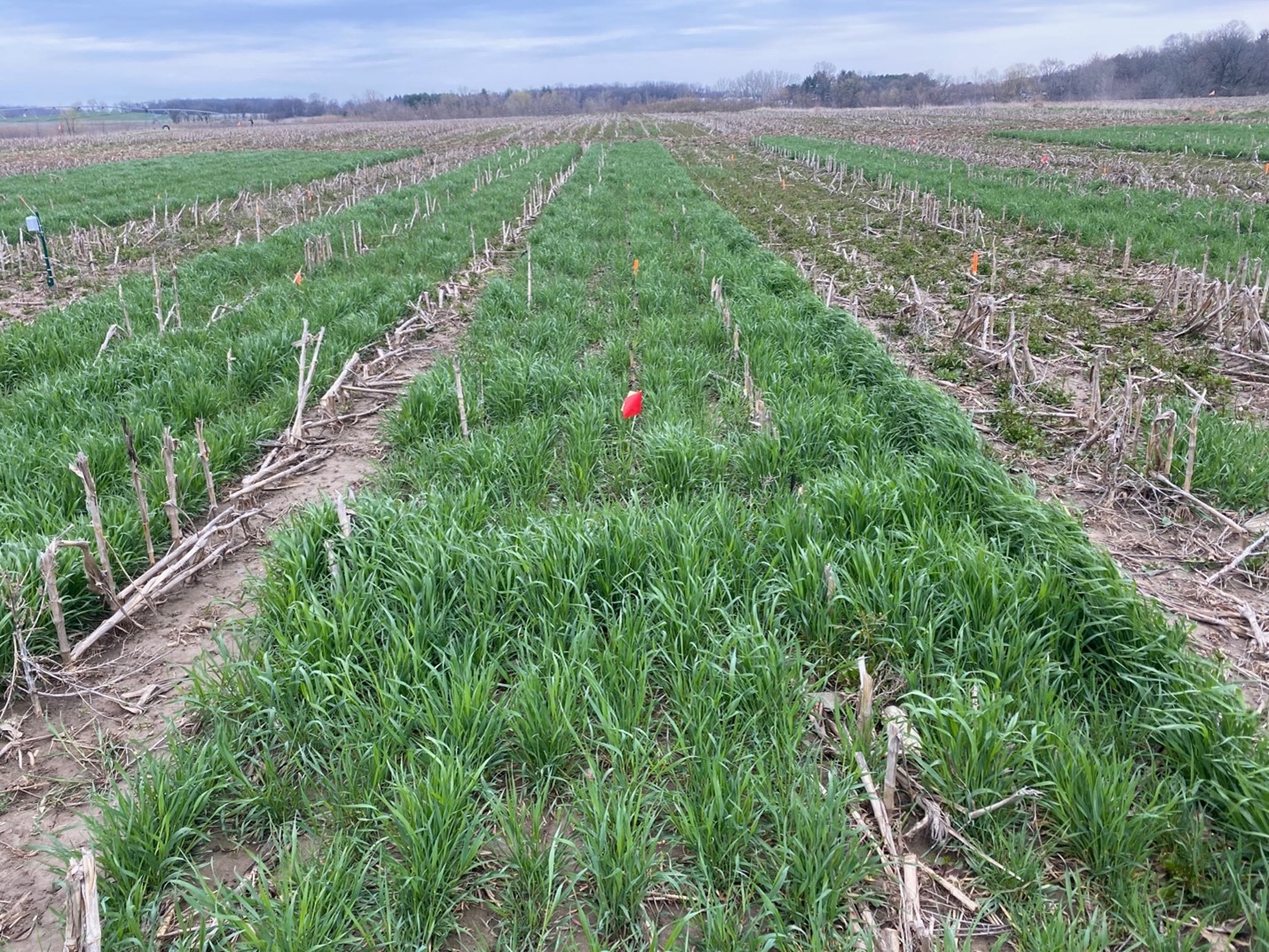Adopting a cereal rye (Secale cereale) cover crop can be a valuable tool for integrated waterhemp (Amaranthus tuberculatus) management when enough cereal rye biomass is accumulated in the spring before the cover crop termination. By enough, we mean 4,500 lbs per acre or more of dry cereal rye biomass. But if you are a soybean farmer in the upper US Midwest, where heat accumulation between fall and spring is a limiting factor for cover crop growth, achieving such levels of biomass in the spring might take a while and require more than just planting a cover crop in the fall (proper cover crop management is necessary). That is where the “planting green system” comes in to help provide your cover crop an opportunity to accumulate adequate levels of biomass (≥4,500 lbs acre) for effective waterhemp suppression (Figure 1).
If you are not familiar with this system, planting green is when the cover crop termination is postponed until or after the soybean planting to give the cover crop extra time to grow. So instead of terminating the cover crop one to two weeks before soybean planting (which most farmers adopting cover crops currently do), the termination is done when the soybean crop is established to help the cereal rye cover crop accumulate those valuable 4,500 lbs of dry biomass for effective waterhemp suppression. Another potential benefit of this approach is that in case you are planning to spray a PRE-emergence herbicide at soybean planting (which we hope you do), you can combine the chemical cereal rye termination (glyphosate serves that purpose very well according to our research) and the PRE-emergence soil residual herbicide applications all in one pass.

The one fear most farmers have regarding this system is the potential soybean yield drag (which concerns us too). We know that soybeans are resilient, and when the cover crop is terminated well in advance of soybean planting, yield reduction is typically unlikely. But what about this planting green idea? To answer this question, we conducted a study over the past two growing seasons (2021 and 2022) to evaluate if the planting green system can help with waterhemp suppression without impacting soybean yield. To give you a more robust answer, besides Wisconsin, we had the help of academic weed scientists from Arkansas, Missouri, Iowa, Illinois, Indiana, Kansas, Kentucky, North Dakota, Ohio, and Pennsylvania to replicate the study and gather a large amount of data. Here is what we have learned from this United Soybean Board sponsored effort thus far:
Cereal rye cover crop response: as expected, cover crop biomass accumulation was higher (average 35% increase) when we adopted the planting green system instead of terminating the cereal rye cover crop two weeks before soybean planting. Even in colder climates like Wisconsin, we managed to accumulate the desired level of cereal rye dry biomass (4,500 lbs per acre) with the planting green system at a reasonable soybean planting time (mid-May). But there is one additional observation here, the cover crop establishment in Wisconsin was successful! We drilled good quality seed of an early-maturing cereal rye variety (Aroostook Winter Rye, Albert Lea Seeds) at an adequate seeding rate (60 lbs acre) early in the fall and had a beautiful stand early in the spring (Figure 2). For our academic colleagues that did not have the same luck and the cover crop stand was poor, most commonly due to poor planting conditions into excessive corn residue in the fall, the cereal rye cover crop biomass did not accumulate at the same pace in the spring. In those cases, they needed to wait a little extra time in the spring to reach the 4,500 lbs per acre biomass target.
Waterhemp response: waterhemp suppression improved with the increase in cereal rye cover crop biomass accumulation in the planting green system. Over a wide range of conditions, the 4,500 lbs of biomass target proved its value and reduced the number of waterhemp plants per square foot at the time of a POST-emergence herbicide application (4-inch waterhemp). Besides reducing the number of waterhemp plants we had to control, the cereal rye cover crop biomass residue also delayed the time for a POST-emergence application. When we have cover crop biomass residue suppressing waterhemp emergence, it might take a little longer for the plants to start to emerge because the cover crop biomass is changing the environment in the soil seed bank (see our previous article: “How we believe cereal rye cover crop suppresses waterhemp”). Despite the benefits of cover crop for waterhemp suppression, this is not a silver bullet that will control 100% of the weeds in your field. So, we still recommend the use of an effective PRE-emergence herbicide as part of your integrated weed management program, especially in cases where the cereal rye cover crop stand (soil coverage) is uneven.
Soybean response: now let’s talk business and discuss soybean yield. Does planting green reduce soybean yield? Well, it depends. In cases where the soybean establishment was successful and no major differences in soybean stand at harvest occurred in the planting green system, there was no yield reduction compared to the no-till without a cover crop or the cover crop terminated 10-14 days before soybean planting. However, in some cases, unfortunately, the planting green system challenged soybean establishment and due to losses in the final stand, the soybean yield was reduced. The good news is that this was not entirely due to the level of cover crop biomass production (not all locations with high cover crop biomass had an yield reduction). It was a combination of high biomass accumulation (>10,000 lbs acre), dry soil at soybean planting due to dry spring conditions (difficult to plant through), and, guilty as charged, lack of experience with this new planting system/conditions.
Moving from planting soybean in conventional tillage, or even no-till, to a system with cover crops is a big step. There is a lot to learn and adapt to, and oftentimes we learn those lessons the hard way. So, our goal with this article is to share the lessons (good and bad) we have learned thus far from this project with you (farmers and practitioners). Because when it comes to cover cropping and planting green, there is a steep learning curve, and we can all benefit from each other’s experiences.

The research reported herein is being led by Jose Junior Nunes (WiscWeeds PhD student). Click here to see Nunes’ slides presented during the 2022 North Central Weed Science Society Meetings (December 2022) in St. Louis, MO. Nunes won second place with this paper presentation (congrats Jose!).
Additional resources:
This article was written by Jose Junior Nunes (PhD Student), Nick Arneson (Outreach Program Manager), and Rodrigo Werle (Assistant Professor). All authors are affiliated with UW-Madison.